Biology > Lab Report > Chamberlain College of Nursing BIOS 255 Week 2 Lab worksheet BIOS 255 Anatomy & Physiology – Ble (All)
Chamberlain College of Nursing BIOS 255 Week 2 Lab worksheet BIOS 255 Anatomy & Physiology – Blended Onsite w/ Physical Laboratory Facility Week 2 Laboratory Module #2
Document Content and Description Below
Chamberlain College of Nursing BIOS 255 Week 2 Lab worksheet BIOS 255 Anatomy & Physiology – Blended Onsite w/ Physical Laboratory Facility Week 2 Laboratory Module #2 Blood Vessels A... ctivity Deliverable Points Part A Pre/Post Exercise Blood Pressure Measurements (see page 7) 10 Part B Critical Analysis of Blood Pressure Measures (see pages 8-9) 20 Part C Lab Manual Exercise 30 (~1 hour) Reviewing Your Knowledge & Using Your Knowledge 10 LABORATORY STEPS PART A: Step 1: Measurement and Computations of Basic Pressure and Flow Measurements. These measurements are completed by each research team that shares their results with other members of the team — each team member is responsible for the correct measurements and computations of basic pressure and flow measurements on their experimental subject. ~ ½ hour Review from the Lab Manual, Exercise 29, pages 463–471. 1.0 — Review pages 3–6 of the laboratory packet 1.2 — Assign the following roles for each experimental team: a. experimental subject – must be in good health and free of cardiovascular problems. In addition, the subject should not have smoked or drank caffeinated beverages for 30 minutes prior to the beginning of the laboratory. b. Blood pressure technician (this role should be rotated as much as possible to allow all members of the research team the opportunity to conduct auscultation for pressure sounds). c. Pulse rate technician. 1.3 — Read through the entire laboratory packet and ask for clarification from your laboratory instructor. 1.4 — Conduct the resting measurements on your experimental subject, record the results, and complete the computations of pulse rate, pulse pressure, mean arterial pressure, and minute cardiac output. 1.5 — Have the experimental subject engage in the five minutes of strenuous exercise. 1.6 — Conduct the post exercise measurements on your experimental subject, record the results, and complete the computations of pulse rate, pulse pressure, mean arterial pressure, and minute cardiac output. LABORATORY STEPS PART B: Step 2: Critical Analysis – completed by all students individually ~ 1 hour LABORATORY STEPS PART C: Step 3: Lab Manual Exercise 30: Blood Vessel Identification ~ 1 hour From Allen and Harper, Laboratory Manual for Anatomy and Physiology 5th ed. Lab Due Date To be turned in by the end of Week 2 References 1 Tortora and Derrickson Introduction to the Human Body, 9th ed., Wiley, 2012. 2 Allen & Harper, Laboratory Manual for Anatomy and Physiology, 5th ed., Wiley, 2014. LABORATORY STEPS PART A: Step 1: Lab Safety Certification and Training ~ 1/2 hour LABORATORY: BLOOD PRESSURE & ALTERATIONS DUE TO EXERCISE BACKGROUND READING ON THE AUSCULTATION METHOD (KOROTKOFF SOUNDS) 1 The first Korotkoff sound is the snapping sound first heard at the systolic pressure. Clear tapping, repetitive sounds for at least two consecutive beats are considered the systolic pressure. 5 The fifth Korotkoff sound is silence as the cuff pressure drops below the diastolic blood pressure. The disappearance of sound is considered diastolic blood pressure -- 2 mmHg above the last sound heard. Equipment 1. Sphygmomanometer: A sphygmomanometer consists of an inflatable bag inside a covering called a cuff, an inflating bulb, and a manometer from which blood pressure can be read, and a valve that is used for deflation. 2. Stethoscope 3. Chair 4. Table or other surface to support arm 5. Stairs or other open space to increase heart rate Preparation For the person being tested: wear clothing that allows your upper arm to be bare. Avoid heavy exercise or eating prior to the test. Don’t smoke or ingest caffeine for at least 30– 60 minutes before being tested. Sit quietly for several minutes before the test begins. Instructions 1. The subject should sit comfortably, with the arm slightly flexed, palm up, and the forearm supported at heart level on a table or other smooth surface. If such a surface isn’t available, you will need to support the subject’s forearm while you take the measurements. 2. Place the deflated cuff on the subject’s upper arm, with the lower edge of the cuff about one inch above the inner elbow crease. The inflatable bag should rest on the brachial artery, which is on the inner part of the upper arm. The inflatable bag should encircle at least 80% of the arm; if it does not, use a larger sphygmomanometer cuff. 3. Apply the stethoscope lightly to the arm, just at the inner elbow crease. Make sure the stethoscope doesn’t touch the cuff, or any of the tubing from the sphygmomanometer. 4. While watching the manometer (pressure gauge of the cuff) and listening for pulse sounds through the stethoscope, inflate the bag about 30 mm Hg above the point at which pulse sounds disappear. (Inflating the bag closes off the blood flow in the brachial artery, causing the pulse sounds to stop.) 5. Slowly deflate the bag at a rate of about 3 mm Hg per second (or per heartbeat). As you release the pressure, pulse sounds will become audible, go through several changes in clarity and intensity, and then disappear again. You must listen carefully to the pulse sounds while you watch the readings on the manometer (This technique of auscultation is based upon the Korotkoff’s method first pioneered at the beginning of the last century — around 1905). DATA PAGE TO BE COMPLETED ON EACH EXPERIMENTAL SUBJECT: RESTING MEASUREMENTS: POST-EXERCISE MEASUREMENTS: AVERAGE COMPARISONS Critical Thinking Questions to be answered for the laboratory and handed in at the end of Week 2. 1 What is the utility of the computation for the mean arterial pressure? How does it differ from pulse pressure? 2 What change(s) occur to blood pressure, MAP & CO immediately after exercise? 3 Why do these changes occur? Blood Pressure Classification Health (NIH Publication No. 03-5233). LAB MANUAL – EXERCISES 30 Exercise 30 Blood Vessel Identification Reviewing Your Knowledge A. Arteries and Veins C. Review of Veins Exercise 30 Blood Vessel Identification Using Your Knowledge A. Blood Vessel Identification [Show More]
Last updated: 1 year ago
Preview 1 out of 15 pages
.png)
Reviews( 0 )
Recommended For You
Biology> Lab Report > Chamberlain College of Nursing BIOS 242 Lab4_SimpleStain. (All)
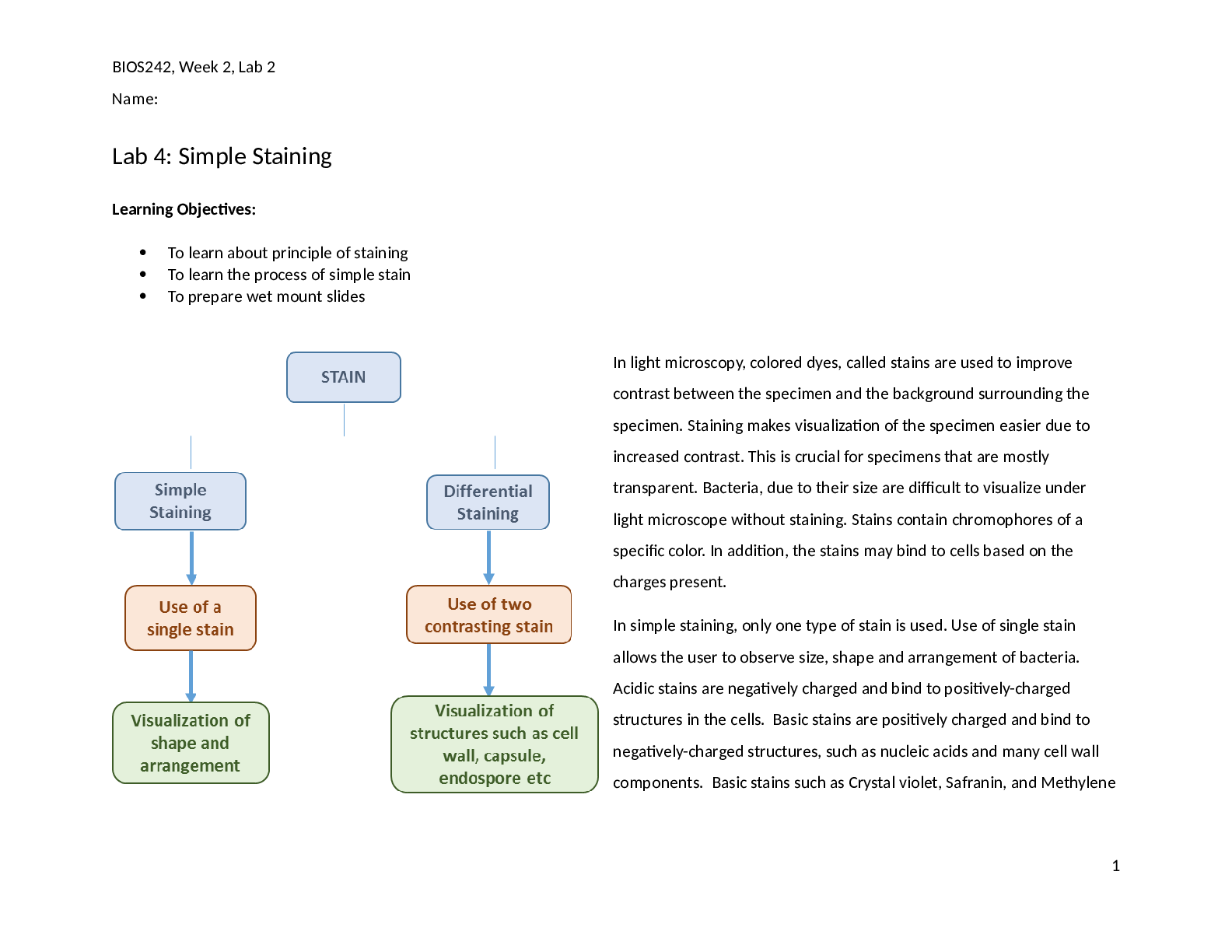
Chamberlain College of Nursing BIOS 242 Lab4_SimpleStain.
BIOS242, Week 2, Lab 2 Name: Lab 4: Simple Staining Learning Objectives: To learn about principle of staining To learn the process of simple stain To prepare wet mount slides In light mic...
By Dr Medina Reed , Uploaded: Oct 08, 2021
$6
Biology> Lab Report > Chamberlain College of Nursing BIOS 255 Power Phys Lab week 6 LABORATORY REPORT Activity: Respiratory Volumes (All)

Chamberlain College of Nursing BIOS 255 Power Phys Lab week 6 LABORATORY REPORT Activity: Respiratory Volumes
Chamberlain College of Nursing BIOS 255 Power Phys Lab week 6 LABORATORY REPORT Activity: Respiratory Volumes Date: 06.04.2018 Predictions 1. During exercise 2. During exercise 3. Dur...
By SuperSolutions© , Uploaded: Nov 07, 2022
$9
Neurology> Lab Report > Chamberlain College of Nursing BIOS 255 Week 4 Lab PART A: Step 1: Analysis of Thymic Tissue and PART B: Step 2: Analysis of Lymphatic Tissue (All)
.png)
Chamberlain College of Nursing BIOS 255 Week 4 Lab PART A: Step 1: Analysis of Thymic Tissue and PART B: Step 2: Analysis of Lymphatic Tissue
Chamberlain College of Nursing BIOS 255 Week 4 Lab PART A: Step 1: Analysis of Thymic Tissue and PART B: Step 2: Analysis of Lymphatic Tissue Thymus Cortex - The cortex of the thymus is the...
By SuperSolutions© , Uploaded: Nov 07, 2022
$8
Physics> Lab Report > PHY 2048L Experiment 4 Lab Report: Force Table, Florida Atlantic University (All)

PHY 2048L Experiment 4 Lab Report: Force Table, Florida Atlantic University
PHY2048L 007: Experiment 4: Force Table February 14, 2020 Purpose The purpose of this experiment is to add a set of vectors using three different methods (graphical, analytical, and experimental)...
By Kirsch , Uploaded: Oct 01, 2020
$9
Chemistry> Lab Report > CHEM 162 Experiment #5 Spectrochemical Series (All)
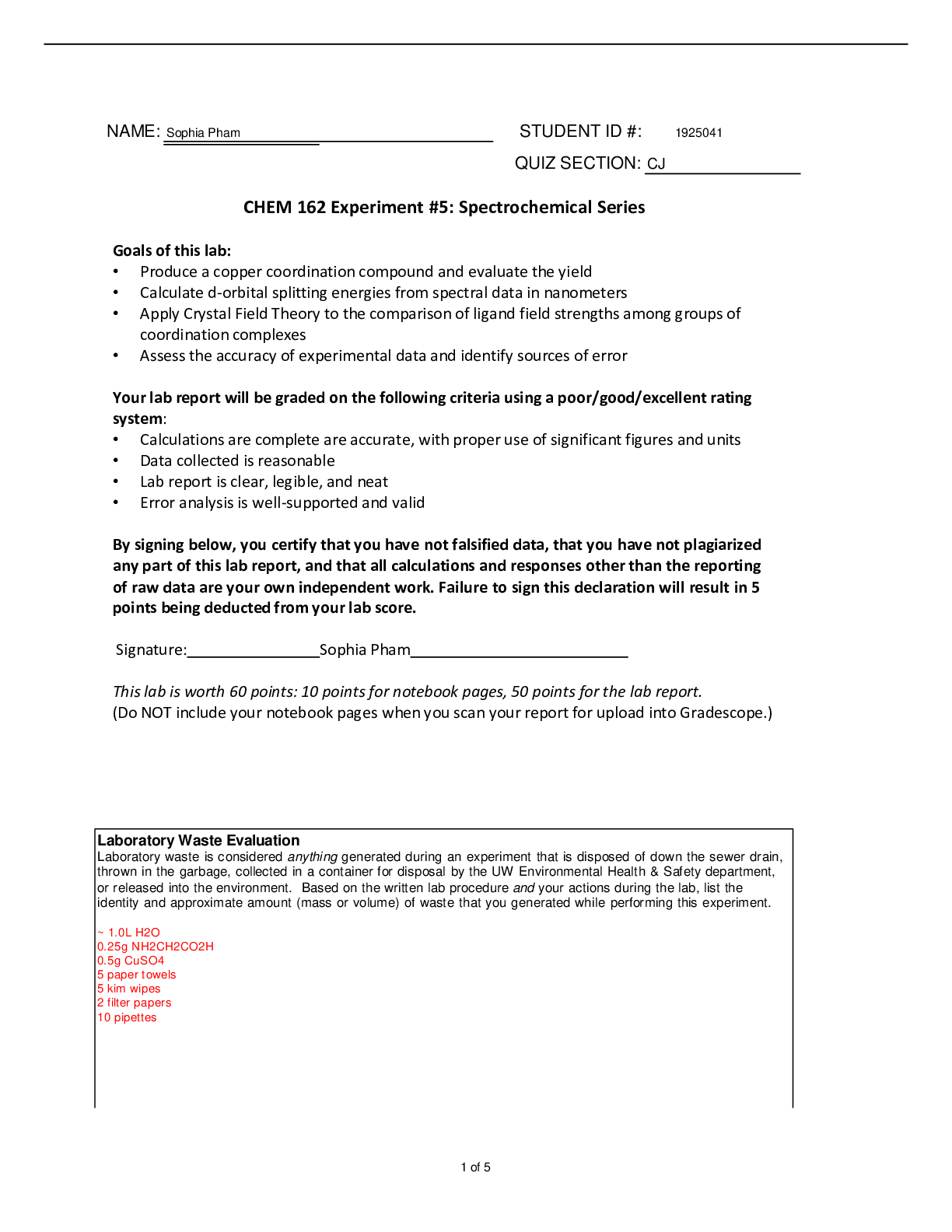
CHEM 162 Experiment #5 Spectrochemical Series
CHEM 162 Experiment #5: Spectrochemical Series Goals of this lab: • Produce a copper coordination compound and evaluate the yield • Calculate d-orbital splitting energies from spectral data in nano...
By Muchiri , Uploaded: May 20, 2021
$9
Environmental Science> Lab Report > ENVR 1401Lab 11 toxicology experiment and lab report Collin College - (All)
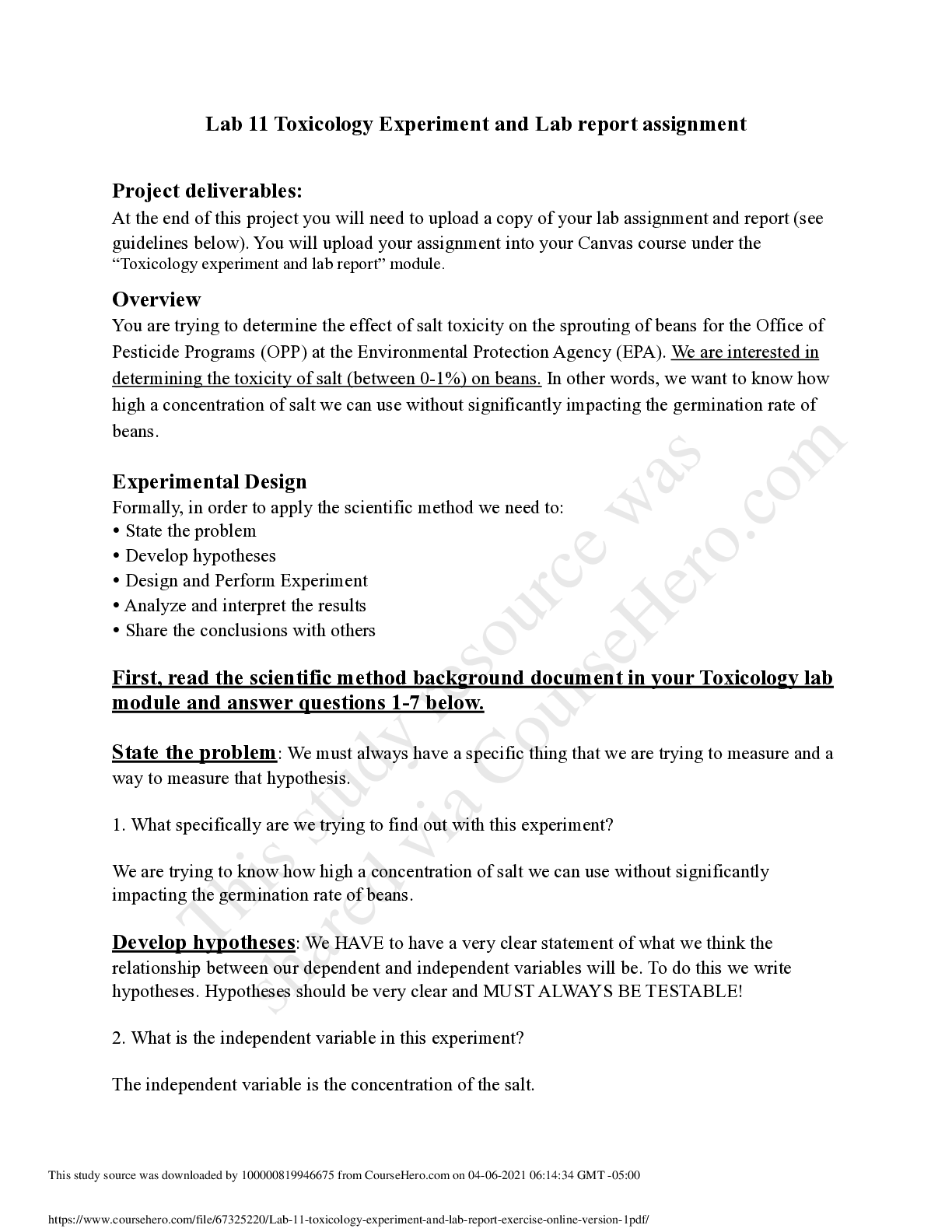
ENVR 1401Lab 11 toxicology experiment and lab report Collin College -
Lab 11 Toxicology Experiment and Lab report assignment Project deliverables: At the end of this project you will need to upload a copy of your lab assignment and report (see guidelines below). You...
By Muchiri , Uploaded: Apr 06, 2021
$10
Biology> Lab Report > BIO 208 Reproductive System, and Development, Growth, and Aging Lab Practical 2. All Correct Answers Indicated. (All)
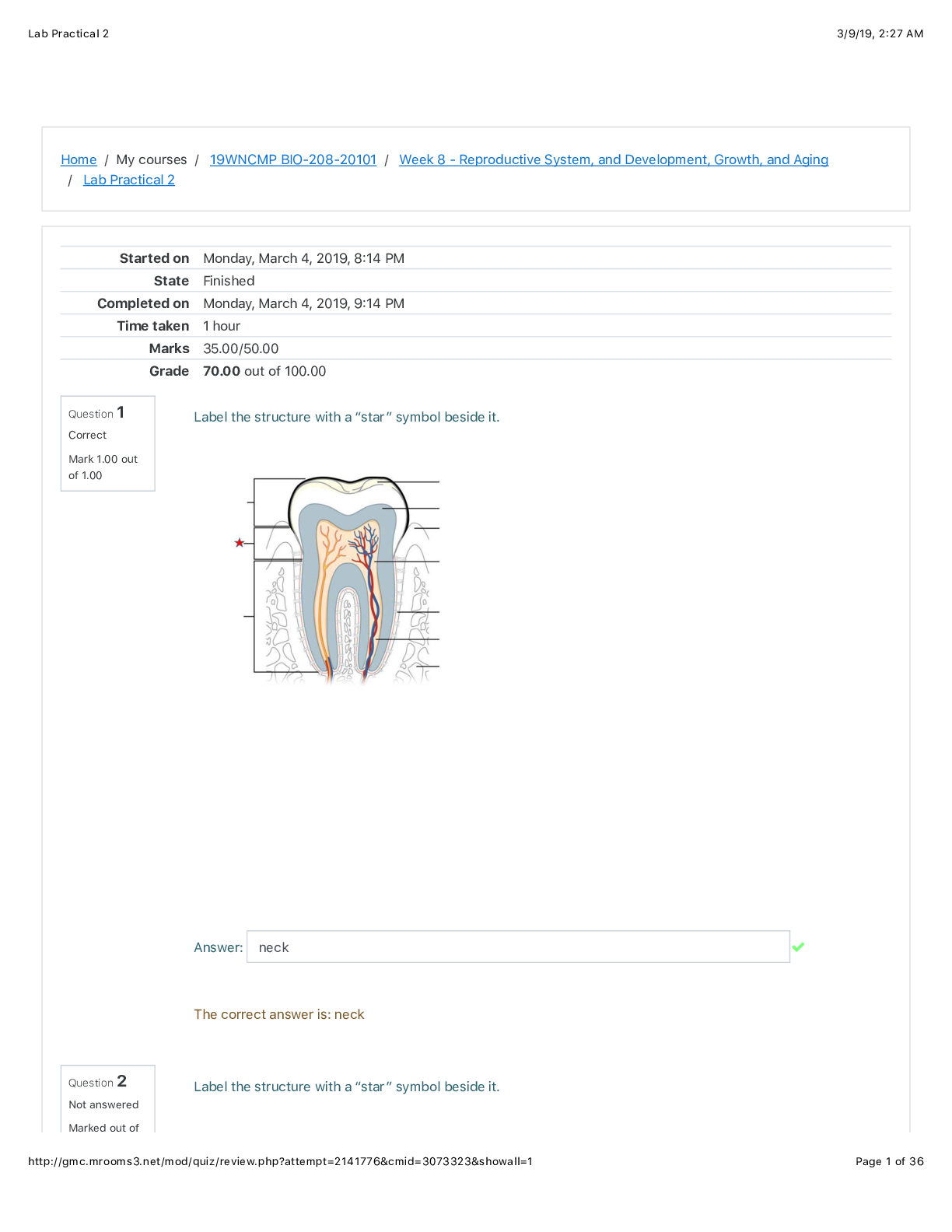
BIO 208 Reproductive System, and Development, Growth, and Aging Lab Practical 2. All Correct Answers Indicated.
Lab Practical Home / My courses / Question 1 Correct Mark 1.00 out of 1.00 Question 2 Not answered Marked out of Started on Monday, March 4, 2019, 8Q14 PM State Finished Completed on M...
By Kirsch , Uploaded: Nov 27, 2020
$10
Physics> Lab Report > PHY 110 Lab 7 - Forces in Every Life. University of New England (All)

PHY 110 Lab 7 - Forces in Every Life. University of New England
Forces in Everyday Life (Week 7) Model or Topic Explored: You will create a demonstration of either the free particle (sum of the forces is equal to zero) or constant force particle (sum of the forc...
By Cheryshev , Uploaded: Jul 02, 2021
$8.5
*NURSING> Lab Report > HPE ProLiant Questions and Answers, Lab Reports for Mathematics (All)
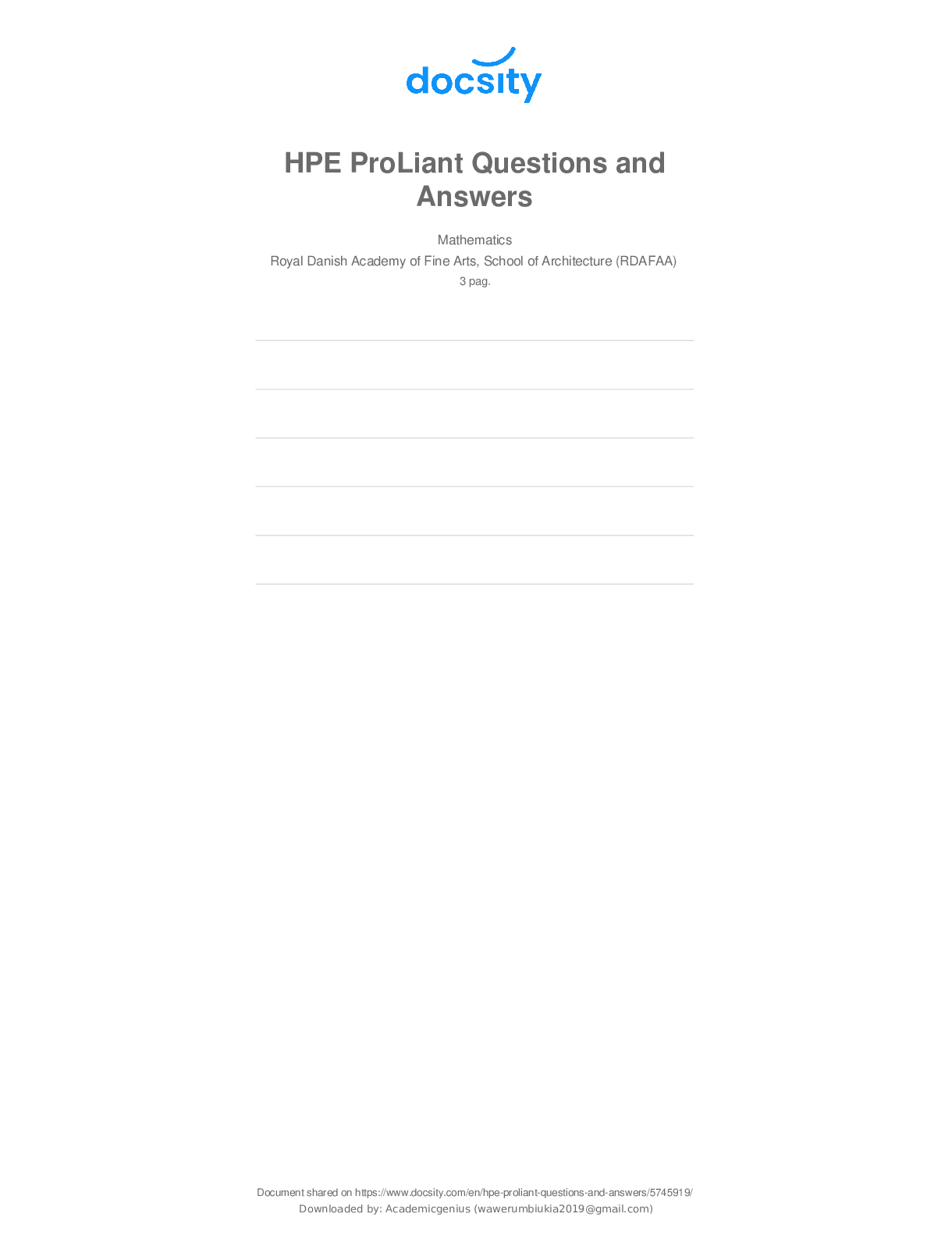
HPE ProLiant Questions and Answers, Lab Reports for Mathematics
HPE ProLiant Questions and Answers, Lab Reports for Mathematics 3.8 (14) Refer to the exhibit of an internal view of the HPE ProLiant WS460c Graphics Server Blade.- HPE Smart Array P244br Controlle...
By WINNIE MUMBI , Uploaded: Nov 12, 2023
$21
Chemistry> Lab Report > Unit 2 assignment 2 - Lab Report on Study of Cooling curves (All)
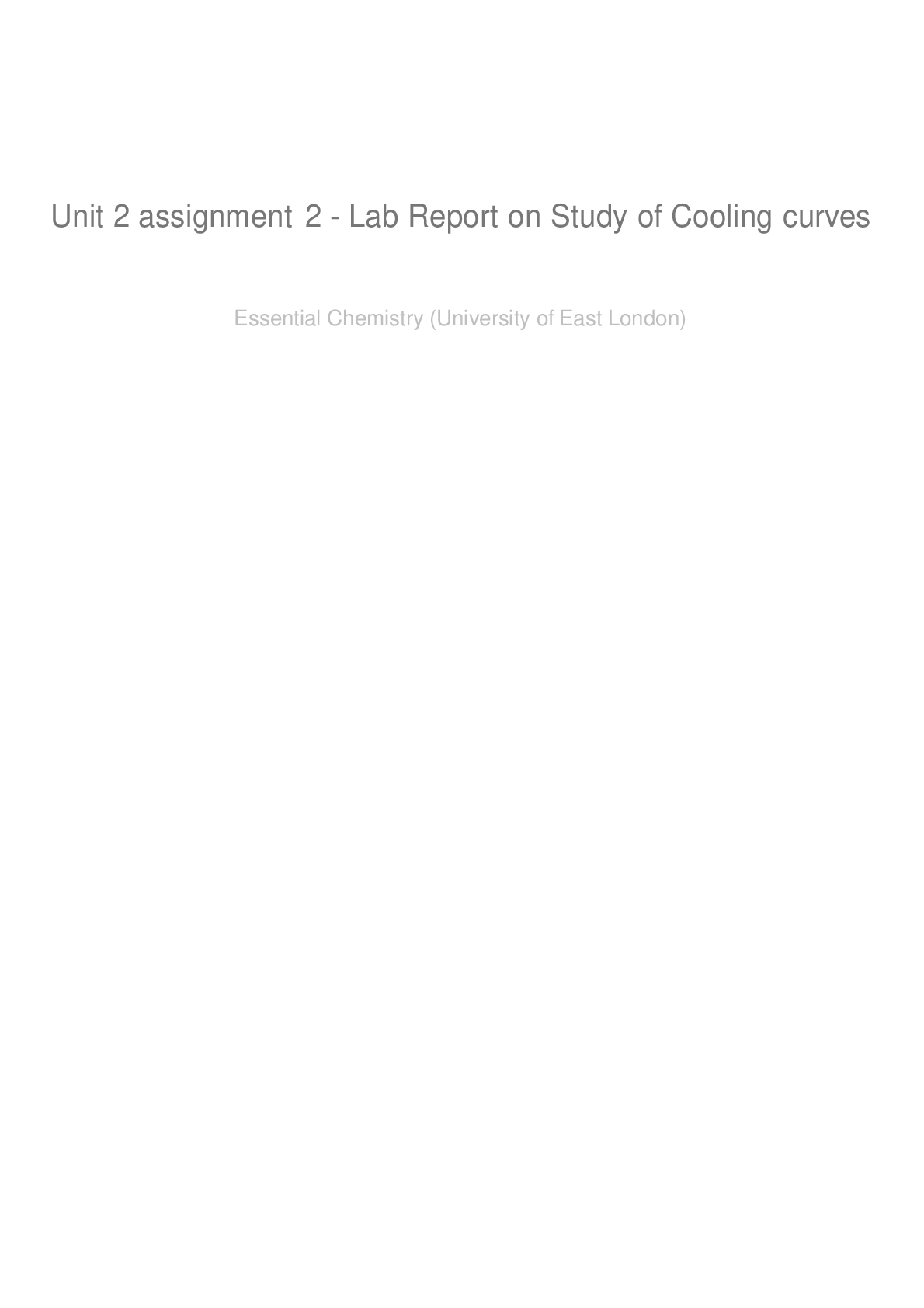
Unit 2 assignment 2 - Lab Report on Study of Cooling curves
Unit 2 assignment 2 - Lab Report on Study of Cooling curves
By ACADEMICTUTORIAL , Uploaded: Dec 22, 2021
$3
Document information
Connected school, study & course
About the document
Uploaded On
Nov 07, 2022
Number of pages
15
Written in
Additional information
This document has been written for:
Uploaded
Nov 07, 2022
Downloads
0
Views
240






